| Timeless Nation |
25. "ECCE HOMO"
(The Fine Arts in Hungary after 1849)
Popular Romanticism
Architecture sought neo-gothic, oriental and exotic forms in protest against the Viennese Biedermeier-Baroque. The search for new Hungarian forms resulted in such interesting examples as the Budapest "Vigado" (Casino and Concert Hall), designed by F. Feszl. This exotic mixture of Byzantine, Moorish and Magyar inspiration reminded an onlooker of a "csardas carved in stone". The new building programme after the Compromise produced some fine examples of eclectic styles, such as the Parliament House (I. Steindl) with its neo-gothic exterior and strangely harmonious Baroque–Renaissance interior. The Opera House (M. Ybl) was built in a more uniform Italian neo-Renaissance style with interior decorations and murals by the best painters of the period. The "Fisherman’s Bastion" (F. Schulek) is a historic recreation of the walls of Buda castle and one of the best-known landmarks of Budapest.
The sculptors turned to the inspiration and dynamism of folk art or to the symbolism of historic figures. Miklos Izso (1831-1875) continued Ferenczy’s search for a national style. Most of his work remained largely experimental. The symbolic "Sorrowing Shepherd" is a poignant expression of the Magyar people’s sorrow. His source of inspiration, the art of the people, resulted in such fine genre figures as the "Dancing Shepherd".Janos Fadrusz created remarkable historical bronze statues (King Matthias at Kolozsvar).
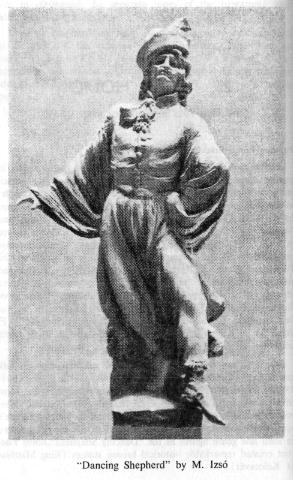
The painters replaced the carefree serenity of French Romanticism with a rather sombre patriotic symbolism. Hungarian realism and folk-inspiration blend in the popular, spectacular historical compositions of the era. Mihaly Zichy is known for his romantic-patriotic illustrations to great literary works of the era. Victor Madarasz found his inspiration in the tragic-heroic events of Hungarian history. The compositions "Ilona Zrinyi Before her Judges", "Zrinyi and Frangepan", "Zrinyi’s Last Sally" and his masterpiece, "The Mourning of Laszlo Hunyadi" clearly convey the spirit of defiance against Austrian oppression.
Bertalan Szekely (1835-1910) had a remarkable sense of composition. He, too, expressed his strong feelings for his nation through historical tableaus with an intense message of defiance. His great composition, "The Finding of the Body of King Louis II", links symbolically the Mohacs disaster with the defeat of the 1848-49 war. Romantic pathos and vivid use of colours characterise "Dobozi" and the "Women of Eger". Needless to say, neither Madarasz nor Szekely received official recognition, let alone support in Hungary under Austrian Oppression. (p.99)
Karoly Lotz on the other hand soon became the favourite of the "official" critics with his pleasing, serene, allegoric (and unpolitical) scenes, murals, tableaus and neo-classic figures ("Girl in Bath", etc.). Gyula Benczur (1844-1920), Professor at the Academy of Munich, shows a belated Rubens influence in his academic compositions, such as the "Baptism of Vajk" and the "Recapture of Buda". His brilliant portraiture and harmonious, precise composition without any dangerous defiant message received official approval in Vienna and Budapest. (p.106)
MihaIy (Michael) Munkacsy
Born in Munkacs (eastern Hungary) in 1844, the son of a freedom fighter in the 1848-49 war, he was orphaned in childhood and placed in a joinery as an apprentice. He soon made himself independent and began painting without any formal education. His talent was soon discovered and he was sent to Vienna to an art school. Here he sold his first paintings: tableaus inspired by his childhood memories of the Freedom War and the landscapes of his country. Thus he was able to finance his further studies in Munich then in Dusseldorf, Germany. His genre paintings and Hungarian landscapes attracted considerable attention. The fine study "The Yawning Apprentice", inspired by memories of his childhood, shows early realist-naturalist influences.
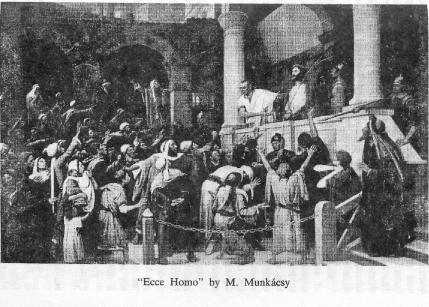
The greatest creation of Munkacsy’s Dusseldorf period "Condemned Cell (1870), is a homage to a childhood idol, a "betyar" (highwayman-freedom-fighter). It represents the fierce spirit of defiance against the Austrian "establishment". The painting gained the coveted Gold Medal of the Paris Salon. This success encouraged Munkacsy to settle in Paris, where he was welcomed by the critics and patrons of the arts. After several successful genre compositions, he painted the striking "Woman carrying Faggots", capturing the contrasting impressions of the fresh vitality of the forest and the tiredness of the old peasant woman. There are many other examples of his dramatic and compassionate approach to poor and old people, such as the "Vagabonds of the Night", Woman Churning Butter" and "Parting".
Munkacsy’s aristocratic French wife drove him to almost frantic activity. "Milton Dictating his Paradise Lost" became his most successful painting to that day. He painted the tragic genius, exiled, blind and deserted by his own family, creating his masterpiece in an atmosphere of loneliness and hate. Though successful, Munkacsy himself was an exile, a lonely man who received no real response from his selfish and snobbish wife; he was without children and without real friends: the French resented the fact that he refused to become a French citizen and the Hungarians disliked him for living in France. So –to some extent – he portrayed himself in Milton.
Munkacsy’s gigantic masterpiece, "Christ before Pilate", was completed in 1881. In it he expresses the contrast of Christ’s dignified silence amid a shouting, hostile crowd with the pallid, hesitating Pilate in the background. After having tried many models for Christ, Munkaesy finally painted his own tormented, sad face. During intervals while working on the majestic tableau, he "relaxed" by painting still-lifes and portraits. Once in a sudden burst of bravado, he painted "Sitting Woman" using 572 shades of blue.
Three years later he completed the "Golgotha": the moment after Christ’s death on the cross and the crowd of spectators. The amazing range of colours includes several shades of white: the deathly pale of Christ’s face, the living white of the mourning women, the pallor of fear on the soldier’s face and many other shades.
Tortured by an old illness and certain of his death, Munkacsy continued to work feverishly: he completed portraits of famous men (Liszt), a mural in Vienna (Mozart) and then a commission from the Hungarian Government to paint the "Conquest of Hungary" for the new Parliament House. His last great work was "Ecce Homo" ("Behold the Man": Pilate shows Christ scourged to the Jews). He painted it while mortally ill, concluding his "Christ Trilogy" and his own life’s work. He died in 1900.
Munkacsy, the toast of his time in Paris and the initiator of an entirely new style, is today hardly known abroad. His unpronounceable name and the fact that he insisted on remaining a "foreigner" in France have made the emotional French forget him quickly. He did not belong to any "school". Most of his masterpieces were snapped up by rich Americans and thus removed from Europe. His own countrymen failed to appreciate his talent. His delicate colours, shades of blue and brown especially, are very hard to reproduce, moreover, many of his original paintings have begun to fade.
Munkacsy’s original style – we may call it "compassionate realism" shows a deep insight into the suffering of the human soul (especially of the poor and old – his favourite models). His portraits and compositions are studies in human psychology: he always grasps a moment of eloquent silence: the principal character has just said something or is about to say something, whilst the secondary characters usually supply a disturbing background of sounds, shouts and abuse.
This great, lonely artist was another example of Hungarian Christian humanism.
Munkacsy’s contemporaries
Laszlo’ Paal, Munkacsy’s friend, spent his short, creative life in France (Barbizon) painting soft, melancholic landscapes. Geza Meszoly was basically a genre painter with a mixture ofMunkacsy’s realism and impressionist colouring ("Balaton Fishermen").
The members of the so-called "Szolnok Group" were influenced by Munkacsy’s themes but added considerable originality to their tableaus. Lajos Deak-Ebner and Sandor Bihari show the precision and vitality of early realism in their peasant scenes.
Pal Szinyei-Merse (1845-1920) was independent from Munkacsy’s realism and the Munich Romanticism. His master-piece, "Picnic in May" ("Majalis"), painted in 1873, used vivid colour schemes reminiscent of French Impressionism – with which he had never been in contact. In fact the great French Impressionists created their masterpieces after Szinyei’s "Picnic". The perfection of his "open air" ("plein air") tonalities is amazing. He seems to have gone a little further than the Impressionists: the effect of air vibration on his colouring is a concept found only in post-Impressionist painting (Cezanne) long after Szinyei’s time.
He painted a few more landscapes and portraits, including the "Woman in Mauve Dress" which has an almost pre-Rafaelite landscape background. Szinyei’s subsequent creations ("The Swing", "Lovers", "The Lark") represent the work of only a few years. He received hostile reception from the critics for his vivid colours and so, discouraged, stopped painting. His "Picnic" was belatedly "discovered" and appreciated three decades after its creation, but by that time Szinyei had lost his interest and initiative. Thus Hungary lost a genius, who could have heralded a modern, XXth century Hungarian art but the country’s artists and critics preferred the comfortable conservatism of the XIXth century.
The period of the Millenlum and World Wars
Szinyei’s "Picnic" inspired a small group of avant–garde painters, called the "Nagybanya Group", around the turn of the century. Their founder, Simon Hollosy, was interested in a wide range of themes, from humorous peasant topics ("Corn Husking") to historic tableaus ("Zrinyi’s Last Sally") with breezy, hazy colours and impressionist experimentation. Karoly Ferenczy, another "Nagybanya" painter, perfected his artistry of light and shade contrasts ("October"). Oscar Glatz’s outdoor tableaus are characterised by his preoccupation with the sun, his indoor compositions are idyllic peasant scenes ("Mother and Child").
The sculptor Fulop 0. Beck (1873-1945) tumed away from the "approved" neo–Baroque styles and pioneered a modern Hungarian art style which was little appreciated by his contemporaries ("Fountain of Youth"). He was also a skilled silversmith and medallist and his plaquettes were more appreciated than his sculptures.
The architect Odon Lechner applied the motifs of Magyar folk art to the decoration – and sometimes even to the forms –of such buildings as the Town Hall of Kecskemet and the Savings Bank of Budapest. He searched for new ways but rejected the reckless eclecticism of some of his contemporaries.
The independent painter, Laszlo Mednydnszky chose scenes of desolation and sadness for his landscapes and city tableaus.
Tivadar Csontvary -Kosztka (1853-1919), the most original genius of Hungarian painting, travelled extensively and began to paint only after his 40th year: his actual artistic career lasted only a decade, and was characterised by a feverish search for his own style: he became the forerunner of surrealism (long before Dali) and symbolism. His landscapes ("Hortobagy", "Tarpatak") are realistic, but in his later compositions he succeeded in creating a hauntingly beautiful, melancholic dream-world of his own, as in his masterpiece, "Lonely Cedar", a defiant, tragic symbol of his own loneliness. The religious-pantheistic-mystic compositions inspired by his travels, "Pilgrimage", "Mary’s Well", "Athens", are products of a visionary genius.
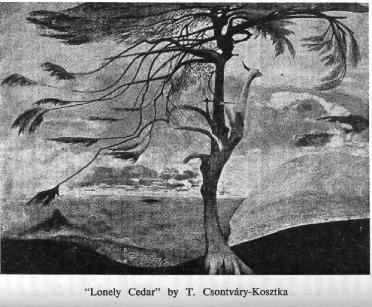
For a while, during the early decades of the XXth century, French influence characterised such popular painters as Jozsef Rippl-Ronai, the creator of serene, cheerful scenes and philosophical portraits ("Flox", "Memories", "My Father"). Istvan Csok (1865-1961), the most successful painter between the wars, worked under the inspiration of French post-impressionism (Renoir). He sought the expression of beauty in children ("Zuzu") and in women fashionably dressed or undressed ("In the Studio", "Hony Soit").
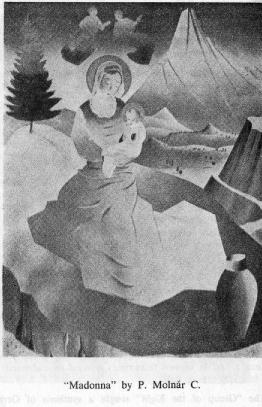
The "Group of the Eight" sought a synthesis of German-inspired expressionism and French art-nouveau trends (Karoly Kernstock). Other avant-garde representatives were the fresco-painter Vilmos Aba-Novak whose expressionist simple figure delineations were set off by glaring, contrasting colours, and the graphic artist Pal C. Molnar. Jeno Paizs-Gobel explored the possibilities of surrealism. Gyula Derkovics, inspired by German expressionism, became interested in tableaus of the proletariat and brought Socialist tendencies into his expression.
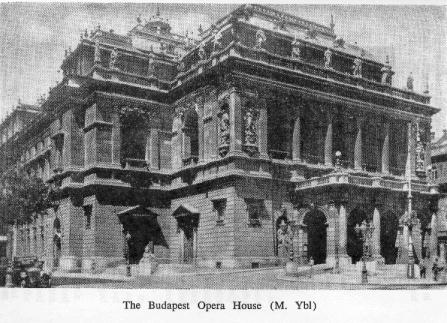
Aurel Bernath and Jozsef Egry used expressionist colouring in their landscapes. Istvan Szonyi chose more robust realism in his powerful landscapes and group tableaus.
The conservative sculptor Zsigmond Kisfaludy-Strobl made his name with academic-style figures. Ferenc Medgyesy, the most remarkable talent of modern Hungarian sculpture, found a harmonious synthesis of classical, modern and Hungarian folk inspiration in his allegorical and sepulchral figures.
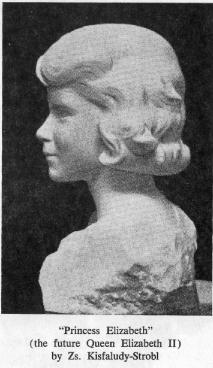
| Timeless Nation |